THE REVERSION OF AMAZONIAN CLICHÉS AT CENTROCENTRO
Madrid's CentroCentro approaches the artistic production related to the Amazon with the exhibition Trópico sin tópico: Amazonas (Tropic without Topic: Amazon), curated by Halim Badawi (Barranquilla, Colombia, 1982), and with which it intends to facilitate new looks beyond the usual ones with which the European imaginary contemplates the indigenous legacy and its relation with the contemporary world.
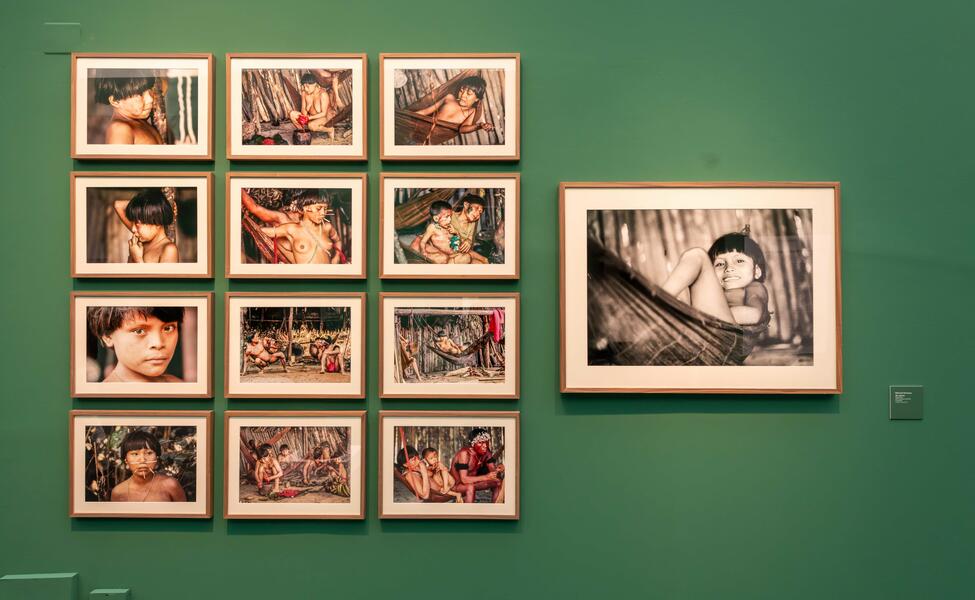
The exhibition features the participation of twenty-five Ibero-American artists who, with their proposals covering techniques such as textile art, photography, sculpture, painting and engraving, try to revert the idealized, distant and aseptic image of the Amazonian indigenous legacy to delve into the political and social problems suffered by these communities.
Within the social section, the exhibition navigates in the difficult balance of the look of the political narratives built from the distance of the purely ethnographic idiosyncrasy, especially in the vision of the traditional, although it has a notable impact on the work of demystification, closer to the thread of the thesis, and the debate on the limits of art and crafts and the productive vision of the same. In addition, the exhibition's line of argument also builds on the aspects of understanding and collaboration once the clichés have been overcome, of coexistence and of the implementation of policies that allow for the construction of that common future.
-
Vista de sala Trópico sin tópico: Amazonas
-
Vista de sala Trópico sin tópico: Amazonas
-
Vista de sala. Trópico sin tópico: Amazonas
-
Vista de sala. Trópico sin tópico: Amazonas
-
Vista de sala. Trópico sin tópico: Amazonas
-
Vista de sala. Trópico sin tópico: Amazonas
-
Vista de sala. Trópico sin tópico: Amazonas
Trópico sin tópico: Amazonas includes Works from Alberto Baraya (Spain and Colombia), José Luis 'Bongore' (Spain and France), Francisco Antonio Cano (Colombia), Antonio Caro (Colombia), Carlos Castro (United States and Colombia), Camilo Egas (Ecuador), Sheroanawe Hakihiiwe (Venezuela), Manuel Herreros de Lemos (Spain and Venezuela), Marlenne Hoffmann (Colombia), Theodor Koch-Grünberg (Germany), Andrés Matías Pinilla (Colombia and Argentina) are participating, Manu Mojito (Colombia), Julieth Morales (Colombia), Delcy Morelos (Colombia), Eduard Moreno (Colombia), Marco Ospina (Colombia), Andrés Orjuela (Mexico and Colombia), Manuel Quintín Lame (Colombia), Amalia Ramírez de Ordóñez (Colombia), Gerardo Reichel-Dolmatoff (Austria and Colombia), José Alejandro Restrepo (Colombia), Abel Rodríguez (Colombia), Olinda Silvano (Peru), Tikuna people (South America), Aimema Úai (Colombia).
Trópico sin tópico: Amazonas can be seen until June 22 at CentroCentro, Plaza de Cibeles, 1, Madrid (Spain).
Related Topics
May interest you

The Hochschild Correa Collection boasts of being the most complete private collection of contemporary art from the Peruvian Amazon. Nevertheless, for more than a decade, it has been built on a varied and unrestricted collection, which has made it possible to bring together the different trends and techniques currently being used in the region, with a focus on dialogue and a certain relational patina among the works that make up the collection.
PERUVIAN AMAZONIAN ART THROUGH THE HOCHSCHILD CORREA COLLECTION
The Hochschild Correa Collection boasts of being the most complete private collection of contemporary art from the Peruvian Amazon. Nevertheless, for more than a decade, it has been built on a varied and unrestricted collection, which has made it possible to bring together the different trends and techniques currently being used in the region, with a focus on dialogue and a certain relational patina among the works that make up the collection.

The Hochschild Correa Collection boasts of being the most complete private collection of contemporary art from the Peruvian Amazon. Nevertheless, for more than a decade, it has been built on a varied and unrestricted collection, which has made it possible to bring together the different trends and techniques currently being used in the region, with a focus on dialogue and a certain relational patina among the works that make up the collection.
PERUVIAN AMAZONIAN ART THROUGH THE HOCHSCHILD CORREA COLLECTION
The Hochschild Correa Collection boasts of being the most complete private collection of contemporary art from the Peruvian Amazon. Nevertheless, for more than a decade, it has been built on a varied and unrestricted collection, which has made it possible to bring together the different trends and techniques currently being used in the region, with a focus on dialogue and a certain relational patina among the works that make up the collection.
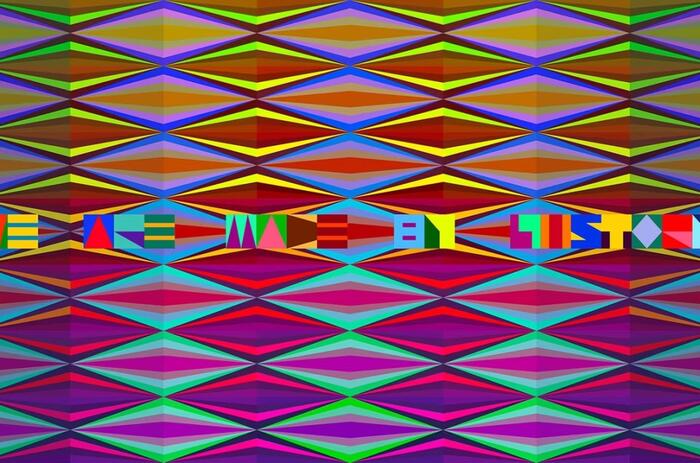
The Broad Museum is set to present Jeffrey Gibson: the space in which to place me, a special exhibition showcasing the artist’s multidimensional work. Adapted from its original presentation at the U.S. Pavilion at the 60th Biennale in 2024, this exhibition marks a historic moment—Gibson was the first Indigenous artist to represent the United States with a solo exhibition.
JEFFREY GIBSON IN LOS ANGELES: A KALEIDOSCOPE OF IDENTITY AND RESISTANCE
The Broad Museum is set to present Jeffrey Gibson: the space in which to place me, a special exhibition showcasing the artist’s multidimensional work. Adapted from its original presentation at the U.S. Pavilion at the 60th Biennale in 2024, this exhibition marks a historic moment—Gibson was the first Indigenous artist to represent the United States with a solo exhibition.

The Miriam and Ira D. Wallach Art Gallery at Columbia University presents Rubén Ortiz-Torres: Zonas de Colaboración, the artist’s first major solo exhibition in New York, curated by Betti-Sue Hertz.
RUBÉN ORTIZ-TORREZ AND THE CULTURAL PARADOXES OF THE GLOBALIZED WORLD
The Miriam and Ira D. Wallach Art Gallery at Columbia University presents Rubén Ortiz-Torres: Zonas de Colaboración, the artist’s first major solo exhibition in New York, curated by Betti-Sue Hertz.
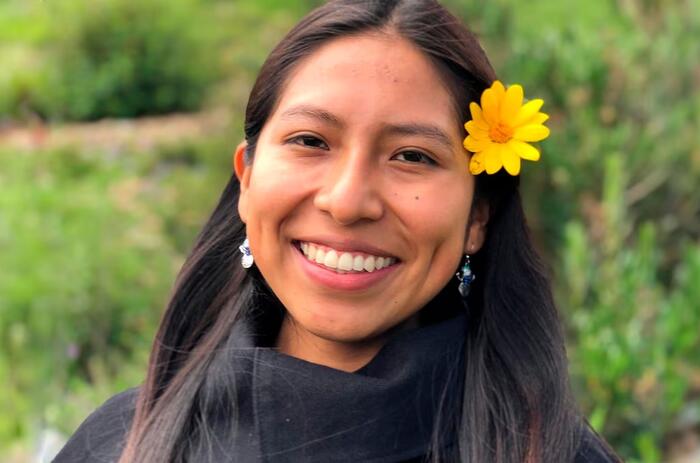
The World Around has announced the winners of its Young Climate Prize, a biennial mentoring and award program aimed at young people under the age of 25. Among them is young Bolivian Dayana Blanco Quiroga.
YOUNG CLIMATE PRIZE 2025 WINNERS
The World Around has announced the winners of its Young Climate Prize, a biennial mentoring and award program aimed at young people under the age of 25. Among them is young Bolivian Dayana Blanco Quiroga.
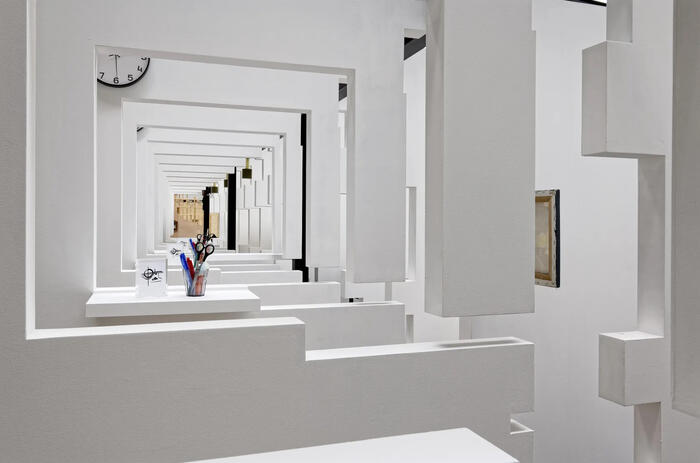
The MIT List Visual Arts Center presents The Great Learning, Pedro Gómez-Egaña’s exhibition that materializes our polyrhythmic experiences of time.
PEDRO GÓMEZ-EGAÑA AND THE MANIFESTATION OF PERCEPTION
The MIT List Visual Arts Center presents The Great Learning, Pedro Gómez-Egaña’s exhibition that materializes our polyrhythmic experiences of time.
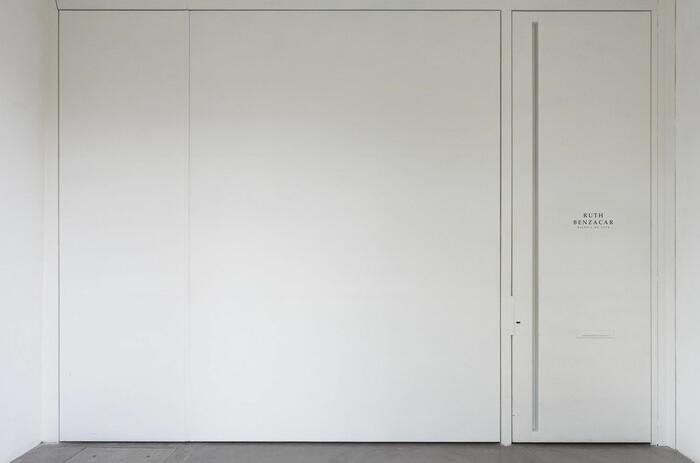
The institution commemorates six decades of trajectory reaffirming its commitment to Argentine artistic production and the continuous development of its scene. To kick off the great year, it presents Estudio para la restauración de un perfil (Study for the Restoration of a Profile) by Ana Gallardo and Alquimia para tiempos turbios (Alchemy for Turbulent Times) by Marina De Caro.
RUTH BENZACAR GALLERY OF ART CELEBRATES 60 YEARS OF HISTORY
The institution commemorates six decades of trajectory reaffirming its commitment to Argentine artistic production and the continuous development of its scene. To kick off the great year, it presents Estudio para la restauración de un perfil (Study for the Restoration of a Profile) by Ana Gallardo and Alquimia para tiempos turbios (Alchemy for Turbulent Times) by Marina De Caro.
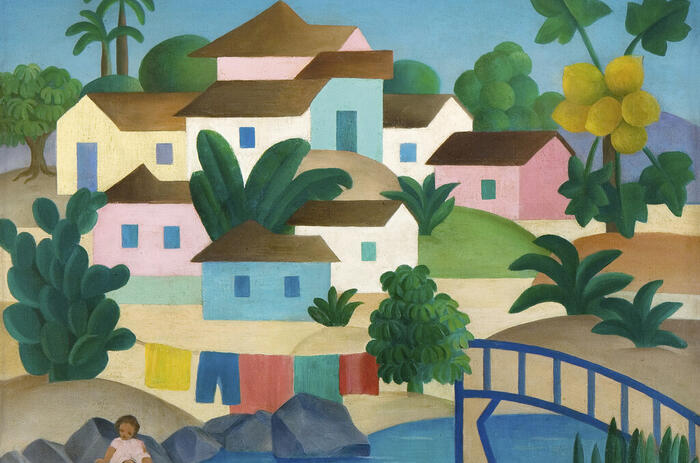
The Guggenheim Museum Bilbao hosts a retrospective exhibition of Tarsila do Amaral (Capivari, Brazil, 1886 - São Paulo, Brazil, 1973) focused on her conception and renovation of painting, as well as on her recognition as one of the key and most representative figures of the entry of avant-garde and modernizing pictorial languages in Latin America. A central name in Brazilian modernism, her style was consecrated as her own identity, a product of her desires and experiences, evoking both indigenous themes and the modernizing processes of a Brazil that was undergoing a constant transformation.
THE MODERNITY OF TARSILA DO AMARAL TAKES OVER THE GUGGENHEIM IN BILBAO
The Guggenheim Museum Bilbao hosts a retrospective exhibition of Tarsila do Amaral (Capivari, Brazil, 1886 - São Paulo, Brazil, 1973) focused on her conception and renovation of painting, as well as on her recognition as one of the key and most representative figures of the entry of avant-garde and modernizing pictorial languages in Latin America. A central name in Brazilian modernism, her style was consecrated as her own identity, a product of her desires and experiences, evoking both indigenous themes and the modernizing processes of a Brazil that was undergoing a constant transformation.
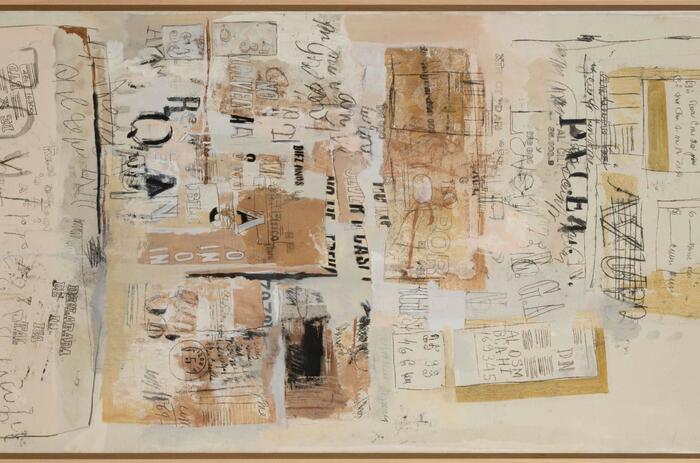
Madrid-based Maisterravalbuena proposes a vindication of the work of Sarah Grilo (Buenos Aires, Argentina,1917 - Madrid, Spain, 2007) through Soluciones para pensar, the second exhibition on this artist at the gallery. With a didactic and rediscovery vocation, the exhibition gathers a selection of paintings in different formats made between the 1960s and 1990s, many of them unpublished to the public. This work of selection and direct work of the gallery with the archive and the legacy of the Argentinean artist becomes fundamental in the structuring of the objective of creating opportunities for a greater knowledge of Grilo's work.
(RE)DISCOVERING SARAH GRILO AT MAISTERRAVALBUENA
Madrid-based Maisterravalbuena proposes a vindication of the work of Sarah Grilo (Buenos Aires, Argentina,1917 - Madrid, Spain, 2007) through Soluciones para pensar, the second exhibition on this artist at the gallery. With a didactic and rediscovery vocation, the exhibition gathers a selection of paintings in different formats made between the 1960s and 1990s, many of them unpublished to the public. This work of selection and direct work of the gallery with the archive and the legacy of the Argentinean artist becomes fundamental in the structuring of the objective of creating opportunities for a greater knowledge of Grilo's work.

The Badischer Kunstverein presents the work of the Brazilian poet and artist in their first extensive solo exhibition in Germany; To See Aloud includes diverse facets of her artistic practice, ranging from early text works, videotext poems, publications and printed matter to photographs, objects, object poems and installations, all the way to her most recent performances and artworks in public spaces, including sound-based and collective activations.
LENORA DE BARROS' EXHIBITION, A MULTISENSORIAL EXPERIENCE
The Badischer Kunstverein presents the work of the Brazilian poet and artist in their first extensive solo exhibition in Germany; To See Aloud includes diverse facets of her artistic practice, ranging from early text works, videotext poems, publications and printed matter to photographs, objects, object poems and installations, all the way to her most recent performances and artworks in public spaces, including sound-based and collective activations.
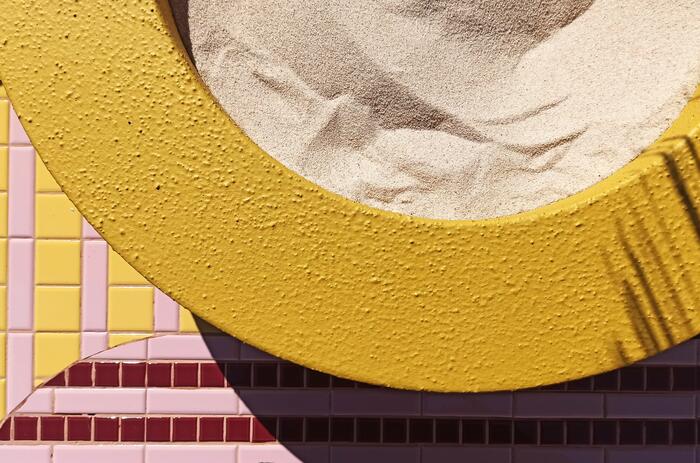
The intervention Wasi Llamkha (Place and touch), by artist Andrea Canepa (Lima, Peru, 1980), stands on the South Patio of Madrid's Condeduque. This pavilion, designed as an ephemeral architectural structure, invites us to explore its sensorial value, far from the preeminence of the visual, and claims, by way of inspiration, the quipus, the forms of representation and recording of information from pre-Columbian Peru.
SPACE AND SENSES IN ANDREA CANEPA
The intervention Wasi Llamkha (Place and touch), by artist Andrea Canepa (Lima, Peru, 1980), stands on the South Patio of Madrid's Condeduque. This pavilion, designed as an ephemeral architectural structure, invites us to explore its sensorial value, far from the preeminence of the visual, and claims, by way of inspiration, the quipus, the forms of representation and recording of information from pre-Columbian Peru.
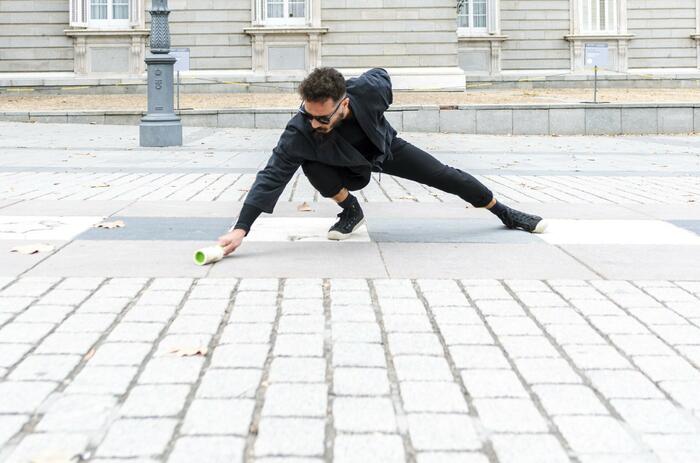
Intricate between action and register, El Apartamento hosts Algo deja quien se va, the first solo exhibition in Spain by Reynier Leyva Novo (Havana, Cuba, 1983). Starting from the political concept of historical memory and linking it to the issues of power and colonialism, the artist unfolds in two well-differentiated series his proposal to approach these lines, and extends his networks to the impact (or influence) they have on the institutional and cultural fabric.
LEYVA NOVO: DUST IT IS AND TO DUST IT WILL TURN
Intricate between action and register, El Apartamento hosts Algo deja quien se va, the first solo exhibition in Spain by Reynier Leyva Novo (Havana, Cuba, 1983). Starting from the political concept of historical memory and linking it to the issues of power and colonialism, the artist unfolds in two well-differentiated series his proposal to approach these lines, and extends his networks to the impact (or influence) they have on the institutional and cultural fabric.
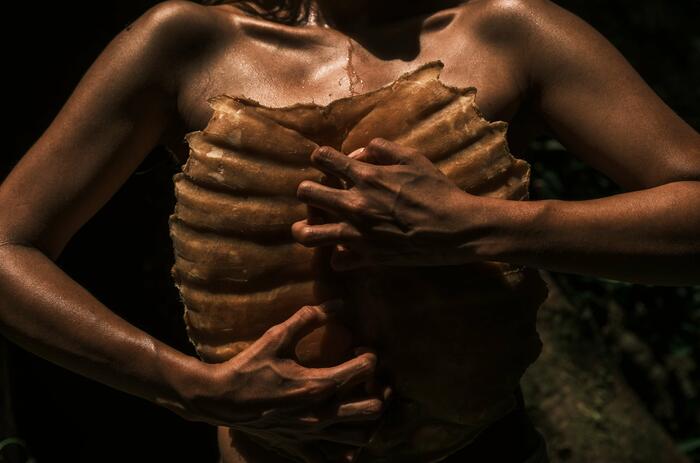
With an innovative perspective and a personal scenic language, KAY presents a play that reveals how the myths of the Amazon have been distorted to conceal the violence lurking over the women and girls of the region. The performance will serve as the closing event of the tenth edition of the prestigious theater and dance festival Temporada Alta, organized by the Alianza Francesa de Lima.
KAY EXPOSES "THE DARK SIDE OF COLLECTIVE MEMORIES" IN LIMA
With an innovative perspective and a personal scenic language, KAY presents a play that reveals how the myths of the Amazon have been distorted to conceal the violence lurking over the women and girls of the region. The performance will serve as the closing event of the tenth edition of the prestigious theater and dance festival Temporada Alta, organized by the Alianza Francesa de Lima.
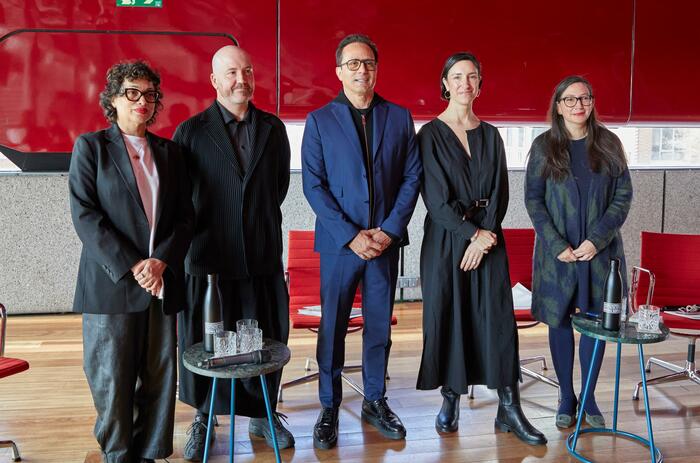
Madrid's Reina Sofia Museum, in collaboration with the Reina Sofia Museum Foundation, reinforces its growing involvement and strategy for the dissemination and study of Latin American contemporary art with the creation of the Cáder Institute of Central American Art (ICAC), dedicated to the research and dissemination of Central American art.
THE CENTRAL AMERICAN ART INSTITUTE (ICAC) OF THE REINA SOFIA MUSEUM IS BORN
Madrid's Reina Sofia Museum, in collaboration with the Reina Sofia Museum Foundation, reinforces its growing involvement and strategy for the dissemination and study of Latin American contemporary art with the creation of the Cáder Institute of Central American Art (ICAC), dedicated to the research and dissemination of Central American art.
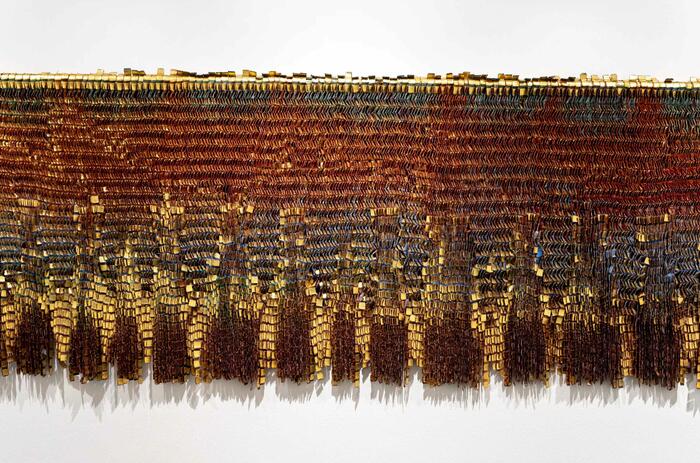
The Institute of Contemporary Art Miami (ICA Miami) presents a retrospective of textile artist Olga de Amaral (Bogotá, 1932), a pioneer in material exploration and the expansion of textile art. The exhibition, in collaboration with the Fondation Cartier pour l’art contemporain in Paris, will be open from May 1 to October 12, showcasing over 50 works spanning six decades of her career, including pieces never before exhibited outside Colombia.
AMARAL IN MIAMI: A JOURNEY THROUGH 60 YEARS OF ARTISTIC EVOLUTION
The Institute of Contemporary Art Miami (ICA Miami) presents a retrospective of textile artist Olga de Amaral (Bogotá, 1932), a pioneer in material exploration and the expansion of textile art. The exhibition, in collaboration with the Fondation Cartier pour l’art contemporain in Paris, will be open from May 1 to October 12, showcasing over 50 works spanning six decades of her career, including pieces never before exhibited outside Colombia.
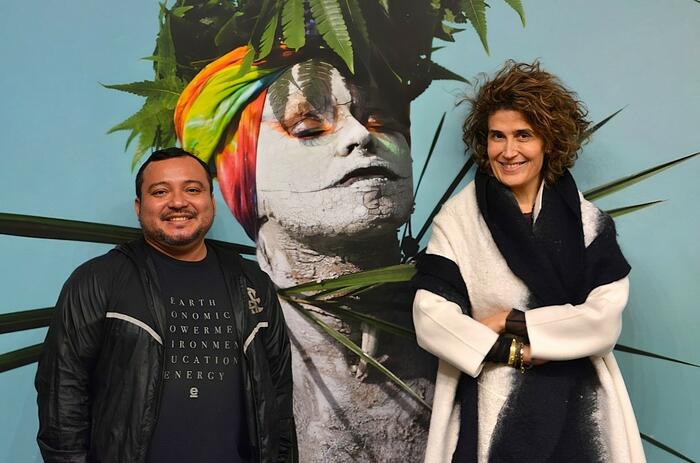
Maria Wills (Bogota, Colombia 1979) and Denilson Baniwa (Barcelos, Brazil, 1984) are the responsible for Wametisé: ideas for an amazofuturism, one of the special programs curated for ARCO 2025 and that navigates the Amazon and its growing impact on contemporary art. This proposal proposes a scenario of representation and dialogue through a selection of galleries and guest artists who will raise, through their works and their realities, the different conceptions of the Amazonian world and the possibilities of a collective future.
MARIA WILLS AND DENILSON BANIWA ON AMAZOFUTURISM
Maria Wills (Bogota, Colombia 1979) and Denilson Baniwa (Barcelos, Brazil, 1984) are the responsible for Wametisé: ideas for an amazofuturism, one of the special programs curated for ARCO 2025 and that navigates the Amazon and its growing impact on contemporary art. This proposal proposes a scenario of representation and dialogue through a selection of galleries and guest artists who will raise, through their works and their realities, the different conceptions of the Amazonian world and the possibilities of a collective future.

The Hochschild Correa Collection boasts of being the most complete private collection of contemporary art from the Peruvian Amazon. Nevertheless, for more than a decade, it has been built on a varied and unrestricted collection, which has made it possible to bring together the different trends and techniques currently being used in the region, with a focus on dialogue and a certain relational patina among the works that make up the collection.
PERUVIAN AMAZONIAN ART THROUGH THE HOCHSCHILD CORREA COLLECTION
The Hochschild Correa Collection boasts of being the most complete private collection of contemporary art from the Peruvian Amazon. Nevertheless, for more than a decade, it has been built on a varied and unrestricted collection, which has made it possible to bring together the different trends and techniques currently being used in the region, with a focus on dialogue and a certain relational patina among the works that make up the collection.

The Broad Museum is set to present Jeffrey Gibson: the space in which to place me, a special exhibition showcasing the artist’s multidimensional work. Adapted from its original presentation at the U.S. Pavilion at the 60th Biennale in 2024, this exhibition marks a historic moment—Gibson was the first Indigenous artist to represent the United States with a solo exhibition.
JEFFREY GIBSON IN LOS ANGELES: A KALEIDOSCOPE OF IDENTITY AND RESISTANCE
The Broad Museum is set to present Jeffrey Gibson: the space in which to place me, a special exhibition showcasing the artist’s multidimensional work. Adapted from its original presentation at the U.S. Pavilion at the 60th Biennale in 2024, this exhibition marks a historic moment—Gibson was the first Indigenous artist to represent the United States with a solo exhibition.

The Miriam and Ira D. Wallach Art Gallery at Columbia University presents Rubén Ortiz-Torres: Zonas de Colaboración, the artist’s first major solo exhibition in New York, curated by Betti-Sue Hertz.
RUBÉN ORTIZ-TORREZ AND THE CULTURAL PARADOXES OF THE GLOBALIZED WORLD
The Miriam and Ira D. Wallach Art Gallery at Columbia University presents Rubén Ortiz-Torres: Zonas de Colaboración, the artist’s first major solo exhibition in New York, curated by Betti-Sue Hertz.

The World Around has announced the winners of its Young Climate Prize, a biennial mentoring and award program aimed at young people under the age of 25. Among them is young Bolivian Dayana Blanco Quiroga.
YOUNG CLIMATE PRIZE 2025 WINNERS
The World Around has announced the winners of its Young Climate Prize, a biennial mentoring and award program aimed at young people under the age of 25. Among them is young Bolivian Dayana Blanco Quiroga.

The MIT List Visual Arts Center presents The Great Learning, Pedro Gómez-Egaña’s exhibition that materializes our polyrhythmic experiences of time.
PEDRO GÓMEZ-EGAÑA AND THE MANIFESTATION OF PERCEPTION
The MIT List Visual Arts Center presents The Great Learning, Pedro Gómez-Egaña’s exhibition that materializes our polyrhythmic experiences of time.

The institution commemorates six decades of trajectory reaffirming its commitment to Argentine artistic production and the continuous development of its scene. To kick off the great year, it presents Estudio para la restauración de un perfil (Study for the Restoration of a Profile) by Ana Gallardo and Alquimia para tiempos turbios (Alchemy for Turbulent Times) by Marina De Caro.
RUTH BENZACAR GALLERY OF ART CELEBRATES 60 YEARS OF HISTORY
The institution commemorates six decades of trajectory reaffirming its commitment to Argentine artistic production and the continuous development of its scene. To kick off the great year, it presents Estudio para la restauración de un perfil (Study for the Restoration of a Profile) by Ana Gallardo and Alquimia para tiempos turbios (Alchemy for Turbulent Times) by Marina De Caro.

The Guggenheim Museum Bilbao hosts a retrospective exhibition of Tarsila do Amaral (Capivari, Brazil, 1886 - São Paulo, Brazil, 1973) focused on her conception and renovation of painting, as well as on her recognition as one of the key and most representative figures of the entry of avant-garde and modernizing pictorial languages in Latin America. A central name in Brazilian modernism, her style was consecrated as her own identity, a product of her desires and experiences, evoking both indigenous themes and the modernizing processes of a Brazil that was undergoing a constant transformation.
THE MODERNITY OF TARSILA DO AMARAL TAKES OVER THE GUGGENHEIM IN BILBAO
The Guggenheim Museum Bilbao hosts a retrospective exhibition of Tarsila do Amaral (Capivari, Brazil, 1886 - São Paulo, Brazil, 1973) focused on her conception and renovation of painting, as well as on her recognition as one of the key and most representative figures of the entry of avant-garde and modernizing pictorial languages in Latin America. A central name in Brazilian modernism, her style was consecrated as her own identity, a product of her desires and experiences, evoking both indigenous themes and the modernizing processes of a Brazil that was undergoing a constant transformation.

Madrid-based Maisterravalbuena proposes a vindication of the work of Sarah Grilo (Buenos Aires, Argentina,1917 - Madrid, Spain, 2007) through Soluciones para pensar, the second exhibition on this artist at the gallery. With a didactic and rediscovery vocation, the exhibition gathers a selection of paintings in different formats made between the 1960s and 1990s, many of them unpublished to the public. This work of selection and direct work of the gallery with the archive and the legacy of the Argentinean artist becomes fundamental in the structuring of the objective of creating opportunities for a greater knowledge of Grilo's work.
(RE)DISCOVERING SARAH GRILO AT MAISTERRAVALBUENA
Madrid-based Maisterravalbuena proposes a vindication of the work of Sarah Grilo (Buenos Aires, Argentina,1917 - Madrid, Spain, 2007) through Soluciones para pensar, the second exhibition on this artist at the gallery. With a didactic and rediscovery vocation, the exhibition gathers a selection of paintings in different formats made between the 1960s and 1990s, many of them unpublished to the public. This work of selection and direct work of the gallery with the archive and the legacy of the Argentinean artist becomes fundamental in the structuring of the objective of creating opportunities for a greater knowledge of Grilo's work.

The Badischer Kunstverein presents the work of the Brazilian poet and artist in their first extensive solo exhibition in Germany; To See Aloud includes diverse facets of her artistic practice, ranging from early text works, videotext poems, publications and printed matter to photographs, objects, object poems and installations, all the way to her most recent performances and artworks in public spaces, including sound-based and collective activations.
LENORA DE BARROS' EXHIBITION, A MULTISENSORIAL EXPERIENCE
The Badischer Kunstverein presents the work of the Brazilian poet and artist in their first extensive solo exhibition in Germany; To See Aloud includes diverse facets of her artistic practice, ranging from early text works, videotext poems, publications and printed matter to photographs, objects, object poems and installations, all the way to her most recent performances and artworks in public spaces, including sound-based and collective activations.

The intervention Wasi Llamkha (Place and touch), by artist Andrea Canepa (Lima, Peru, 1980), stands on the South Patio of Madrid's Condeduque. This pavilion, designed as an ephemeral architectural structure, invites us to explore its sensorial value, far from the preeminence of the visual, and claims, by way of inspiration, the quipus, the forms of representation and recording of information from pre-Columbian Peru.
SPACE AND SENSES IN ANDREA CANEPA
The intervention Wasi Llamkha (Place and touch), by artist Andrea Canepa (Lima, Peru, 1980), stands on the South Patio of Madrid's Condeduque. This pavilion, designed as an ephemeral architectural structure, invites us to explore its sensorial value, far from the preeminence of the visual, and claims, by way of inspiration, the quipus, the forms of representation and recording of information from pre-Columbian Peru.

Intricate between action and register, El Apartamento hosts Algo deja quien se va, the first solo exhibition in Spain by Reynier Leyva Novo (Havana, Cuba, 1983). Starting from the political concept of historical memory and linking it to the issues of power and colonialism, the artist unfolds in two well-differentiated series his proposal to approach these lines, and extends his networks to the impact (or influence) they have on the institutional and cultural fabric.
LEYVA NOVO: DUST IT IS AND TO DUST IT WILL TURN
Intricate between action and register, El Apartamento hosts Algo deja quien se va, the first solo exhibition in Spain by Reynier Leyva Novo (Havana, Cuba, 1983). Starting from the political concept of historical memory and linking it to the issues of power and colonialism, the artist unfolds in two well-differentiated series his proposal to approach these lines, and extends his networks to the impact (or influence) they have on the institutional and cultural fabric.

With an innovative perspective and a personal scenic language, KAY presents a play that reveals how the myths of the Amazon have been distorted to conceal the violence lurking over the women and girls of the region. The performance will serve as the closing event of the tenth edition of the prestigious theater and dance festival Temporada Alta, organized by the Alianza Francesa de Lima.
KAY EXPOSES "THE DARK SIDE OF COLLECTIVE MEMORIES" IN LIMA
With an innovative perspective and a personal scenic language, KAY presents a play that reveals how the myths of the Amazon have been distorted to conceal the violence lurking over the women and girls of the region. The performance will serve as the closing event of the tenth edition of the prestigious theater and dance festival Temporada Alta, organized by the Alianza Francesa de Lima.

Madrid's Reina Sofia Museum, in collaboration with the Reina Sofia Museum Foundation, reinforces its growing involvement and strategy for the dissemination and study of Latin American contemporary art with the creation of the Cáder Institute of Central American Art (ICAC), dedicated to the research and dissemination of Central American art.
THE CENTRAL AMERICAN ART INSTITUTE (ICAC) OF THE REINA SOFIA MUSEUM IS BORN
Madrid's Reina Sofia Museum, in collaboration with the Reina Sofia Museum Foundation, reinforces its growing involvement and strategy for the dissemination and study of Latin American contemporary art with the creation of the Cáder Institute of Central American Art (ICAC), dedicated to the research and dissemination of Central American art.

The Institute of Contemporary Art Miami (ICA Miami) presents a retrospective of textile artist Olga de Amaral (Bogotá, 1932), a pioneer in material exploration and the expansion of textile art. The exhibition, in collaboration with the Fondation Cartier pour l’art contemporain in Paris, will be open from May 1 to October 12, showcasing over 50 works spanning six decades of her career, including pieces never before exhibited outside Colombia.
AMARAL IN MIAMI: A JOURNEY THROUGH 60 YEARS OF ARTISTIC EVOLUTION
The Institute of Contemporary Art Miami (ICA Miami) presents a retrospective of textile artist Olga de Amaral (Bogotá, 1932), a pioneer in material exploration and the expansion of textile art. The exhibition, in collaboration with the Fondation Cartier pour l’art contemporain in Paris, will be open from May 1 to October 12, showcasing over 50 works spanning six decades of her career, including pieces never before exhibited outside Colombia.

Maria Wills (Bogota, Colombia 1979) and Denilson Baniwa (Barcelos, Brazil, 1984) are the responsible for Wametisé: ideas for an amazofuturism, one of the special programs curated for ARCO 2025 and that navigates the Amazon and its growing impact on contemporary art. This proposal proposes a scenario of representation and dialogue through a selection of galleries and guest artists who will raise, through their works and their realities, the different conceptions of the Amazonian world and the possibilities of a collective future.
MARIA WILLS AND DENILSON BANIWA ON AMAZOFUTURISM
Maria Wills (Bogota, Colombia 1979) and Denilson Baniwa (Barcelos, Brazil, 1984) are the responsible for Wametisé: ideas for an amazofuturism, one of the special programs curated for ARCO 2025 and that navigates the Amazon and its growing impact on contemporary art. This proposal proposes a scenario of representation and dialogue through a selection of galleries and guest artists who will raise, through their works and their realities, the different conceptions of the Amazonian world and the possibilities of a collective future.

The Hochschild Correa Collection boasts of being the most complete private collection of contemporary art from the Peruvian Amazon. Nevertheless, for more than a decade, it has been built on a varied and unrestricted collection, which has made it possible to bring together the different trends and techniques currently being used in the region, with a focus on dialogue and a certain relational patina among the works that make up the collection.
PERUVIAN AMAZONIAN ART THROUGH THE HOCHSCHILD CORREA COLLECTION
The Hochschild Correa Collection boasts of being the most complete private collection of contemporary art from the Peruvian Amazon. Nevertheless, for more than a decade, it has been built on a varied and unrestricted collection, which has made it possible to bring together the different trends and techniques currently being used in the region, with a focus on dialogue and a certain relational patina among the works that make up the collection.

The Broad Museum is set to present Jeffrey Gibson: the space in which to place me, a special exhibition showcasing the artist’s multidimensional work. Adapted from its original presentation at the U.S. Pavilion at the 60th Biennale in 2024, this exhibition marks a historic moment—Gibson was the first Indigenous artist to represent the United States with a solo exhibition.
JEFFREY GIBSON IN LOS ANGELES: A KALEIDOSCOPE OF IDENTITY AND RESISTANCE
The Broad Museum is set to present Jeffrey Gibson: the space in which to place me, a special exhibition showcasing the artist’s multidimensional work. Adapted from its original presentation at the U.S. Pavilion at the 60th Biennale in 2024, this exhibition marks a historic moment—Gibson was the first Indigenous artist to represent the United States with a solo exhibition.

The Miriam and Ira D. Wallach Art Gallery at Columbia University presents Rubén Ortiz-Torres: Zonas de Colaboración, the artist’s first major solo exhibition in New York, curated by Betti-Sue Hertz.
RUBÉN ORTIZ-TORREZ AND THE CULTURAL PARADOXES OF THE GLOBALIZED WORLD
The Miriam and Ira D. Wallach Art Gallery at Columbia University presents Rubén Ortiz-Torres: Zonas de Colaboración, the artist’s first major solo exhibition in New York, curated by Betti-Sue Hertz.

The World Around has announced the winners of its Young Climate Prize, a biennial mentoring and award program aimed at young people under the age of 25. Among them is young Bolivian Dayana Blanco Quiroga.
YOUNG CLIMATE PRIZE 2025 WINNERS
The World Around has announced the winners of its Young Climate Prize, a biennial mentoring and award program aimed at young people under the age of 25. Among them is young Bolivian Dayana Blanco Quiroga.

The MIT List Visual Arts Center presents The Great Learning, Pedro Gómez-Egaña’s exhibition that materializes our polyrhythmic experiences of time.
PEDRO GÓMEZ-EGAÑA AND THE MANIFESTATION OF PERCEPTION
The MIT List Visual Arts Center presents The Great Learning, Pedro Gómez-Egaña’s exhibition that materializes our polyrhythmic experiences of time.

The institution commemorates six decades of trajectory reaffirming its commitment to Argentine artistic production and the continuous development of its scene. To kick off the great year, it presents Estudio para la restauración de un perfil (Study for the Restoration of a Profile) by Ana Gallardo and Alquimia para tiempos turbios (Alchemy for Turbulent Times) by Marina De Caro.
RUTH BENZACAR GALLERY OF ART CELEBRATES 60 YEARS OF HISTORY
The institution commemorates six decades of trajectory reaffirming its commitment to Argentine artistic production and the continuous development of its scene. To kick off the great year, it presents Estudio para la restauración de un perfil (Study for the Restoration of a Profile) by Ana Gallardo and Alquimia para tiempos turbios (Alchemy for Turbulent Times) by Marina De Caro.

The Guggenheim Museum Bilbao hosts a retrospective exhibition of Tarsila do Amaral (Capivari, Brazil, 1886 - São Paulo, Brazil, 1973) focused on her conception and renovation of painting, as well as on her recognition as one of the key and most representative figures of the entry of avant-garde and modernizing pictorial languages in Latin America. A central name in Brazilian modernism, her style was consecrated as her own identity, a product of her desires and experiences, evoking both indigenous themes and the modernizing processes of a Brazil that was undergoing a constant transformation.
THE MODERNITY OF TARSILA DO AMARAL TAKES OVER THE GUGGENHEIM IN BILBAO
The Guggenheim Museum Bilbao hosts a retrospective exhibition of Tarsila do Amaral (Capivari, Brazil, 1886 - São Paulo, Brazil, 1973) focused on her conception and renovation of painting, as well as on her recognition as one of the key and most representative figures of the entry of avant-garde and modernizing pictorial languages in Latin America. A central name in Brazilian modernism, her style was consecrated as her own identity, a product of her desires and experiences, evoking both indigenous themes and the modernizing processes of a Brazil that was undergoing a constant transformation.

Madrid-based Maisterravalbuena proposes a vindication of the work of Sarah Grilo (Buenos Aires, Argentina,1917 - Madrid, Spain, 2007) through Soluciones para pensar, the second exhibition on this artist at the gallery. With a didactic and rediscovery vocation, the exhibition gathers a selection of paintings in different formats made between the 1960s and 1990s, many of them unpublished to the public. This work of selection and direct work of the gallery with the archive and the legacy of the Argentinean artist becomes fundamental in the structuring of the objective of creating opportunities for a greater knowledge of Grilo's work.
(RE)DISCOVERING SARAH GRILO AT MAISTERRAVALBUENA
Madrid-based Maisterravalbuena proposes a vindication of the work of Sarah Grilo (Buenos Aires, Argentina,1917 - Madrid, Spain, 2007) through Soluciones para pensar, the second exhibition on this artist at the gallery. With a didactic and rediscovery vocation, the exhibition gathers a selection of paintings in different formats made between the 1960s and 1990s, many of them unpublished to the public. This work of selection and direct work of the gallery with the archive and the legacy of the Argentinean artist becomes fundamental in the structuring of the objective of creating opportunities for a greater knowledge of Grilo's work.

The Badischer Kunstverein presents the work of the Brazilian poet and artist in their first extensive solo exhibition in Germany; To See Aloud includes diverse facets of her artistic practice, ranging from early text works, videotext poems, publications and printed matter to photographs, objects, object poems and installations, all the way to her most recent performances and artworks in public spaces, including sound-based and collective activations.
LENORA DE BARROS' EXHIBITION, A MULTISENSORIAL EXPERIENCE
The Badischer Kunstverein presents the work of the Brazilian poet and artist in their first extensive solo exhibition in Germany; To See Aloud includes diverse facets of her artistic practice, ranging from early text works, videotext poems, publications and printed matter to photographs, objects, object poems and installations, all the way to her most recent performances and artworks in public spaces, including sound-based and collective activations.

The intervention Wasi Llamkha (Place and touch), by artist Andrea Canepa (Lima, Peru, 1980), stands on the South Patio of Madrid's Condeduque. This pavilion, designed as an ephemeral architectural structure, invites us to explore its sensorial value, far from the preeminence of the visual, and claims, by way of inspiration, the quipus, the forms of representation and recording of information from pre-Columbian Peru.
SPACE AND SENSES IN ANDREA CANEPA
The intervention Wasi Llamkha (Place and touch), by artist Andrea Canepa (Lima, Peru, 1980), stands on the South Patio of Madrid's Condeduque. This pavilion, designed as an ephemeral architectural structure, invites us to explore its sensorial value, far from the preeminence of the visual, and claims, by way of inspiration, the quipus, the forms of representation and recording of information from pre-Columbian Peru.

Intricate between action and register, El Apartamento hosts Algo deja quien se va, the first solo exhibition in Spain by Reynier Leyva Novo (Havana, Cuba, 1983). Starting from the political concept of historical memory and linking it to the issues of power and colonialism, the artist unfolds in two well-differentiated series his proposal to approach these lines, and extends his networks to the impact (or influence) they have on the institutional and cultural fabric.
LEYVA NOVO: DUST IT IS AND TO DUST IT WILL TURN
Intricate between action and register, El Apartamento hosts Algo deja quien se va, the first solo exhibition in Spain by Reynier Leyva Novo (Havana, Cuba, 1983). Starting from the political concept of historical memory and linking it to the issues of power and colonialism, the artist unfolds in two well-differentiated series his proposal to approach these lines, and extends his networks to the impact (or influence) they have on the institutional and cultural fabric.

With an innovative perspective and a personal scenic language, KAY presents a play that reveals how the myths of the Amazon have been distorted to conceal the violence lurking over the women and girls of the region. The performance will serve as the closing event of the tenth edition of the prestigious theater and dance festival Temporada Alta, organized by the Alianza Francesa de Lima.
KAY EXPOSES "THE DARK SIDE OF COLLECTIVE MEMORIES" IN LIMA
With an innovative perspective and a personal scenic language, KAY presents a play that reveals how the myths of the Amazon have been distorted to conceal the violence lurking over the women and girls of the region. The performance will serve as the closing event of the tenth edition of the prestigious theater and dance festival Temporada Alta, organized by the Alianza Francesa de Lima.

Madrid's Reina Sofia Museum, in collaboration with the Reina Sofia Museum Foundation, reinforces its growing involvement and strategy for the dissemination and study of Latin American contemporary art with the creation of the Cáder Institute of Central American Art (ICAC), dedicated to the research and dissemination of Central American art.
THE CENTRAL AMERICAN ART INSTITUTE (ICAC) OF THE REINA SOFIA MUSEUM IS BORN
Madrid's Reina Sofia Museum, in collaboration with the Reina Sofia Museum Foundation, reinforces its growing involvement and strategy for the dissemination and study of Latin American contemporary art with the creation of the Cáder Institute of Central American Art (ICAC), dedicated to the research and dissemination of Central American art.

The Institute of Contemporary Art Miami (ICA Miami) presents a retrospective of textile artist Olga de Amaral (Bogotá, 1932), a pioneer in material exploration and the expansion of textile art. The exhibition, in collaboration with the Fondation Cartier pour l’art contemporain in Paris, will be open from May 1 to October 12, showcasing over 50 works spanning six decades of her career, including pieces never before exhibited outside Colombia.
AMARAL IN MIAMI: A JOURNEY THROUGH 60 YEARS OF ARTISTIC EVOLUTION
The Institute of Contemporary Art Miami (ICA Miami) presents a retrospective of textile artist Olga de Amaral (Bogotá, 1932), a pioneer in material exploration and the expansion of textile art. The exhibition, in collaboration with the Fondation Cartier pour l’art contemporain in Paris, will be open from May 1 to October 12, showcasing over 50 works spanning six decades of her career, including pieces never before exhibited outside Colombia.

Maria Wills (Bogota, Colombia 1979) and Denilson Baniwa (Barcelos, Brazil, 1984) are the responsible for Wametisé: ideas for an amazofuturism, one of the special programs curated for ARCO 2025 and that navigates the Amazon and its growing impact on contemporary art. This proposal proposes a scenario of representation and dialogue through a selection of galleries and guest artists who will raise, through their works and their realities, the different conceptions of the Amazonian world and the possibilities of a collective future.
MARIA WILLS AND DENILSON BANIWA ON AMAZOFUTURISM
Maria Wills (Bogota, Colombia 1979) and Denilson Baniwa (Barcelos, Brazil, 1984) are the responsible for Wametisé: ideas for an amazofuturism, one of the special programs curated for ARCO 2025 and that navigates the Amazon and its growing impact on contemporary art. This proposal proposes a scenario of representation and dialogue through a selection of galleries and guest artists who will raise, through their works and their realities, the different conceptions of the Amazonian world and the possibilities of a collective future.

The Hochschild Correa Collection boasts of being the most complete private collection of contemporary art from the Peruvian Amazon. Nevertheless, for more than a decade, it has been built on a varied and unrestricted collection, which has made it possible to bring together the different trends and techniques currently being used in the region, with a focus on dialogue and a certain relational patina among the works that make up the collection.
PERUVIAN AMAZONIAN ART THROUGH THE HOCHSCHILD CORREA COLLECTION
The Hochschild Correa Collection boasts of being the most complete private collection of contemporary art from the Peruvian Amazon. Nevertheless, for more than a decade, it has been built on a varied and unrestricted collection, which has made it possible to bring together the different trends and techniques currently being used in the region, with a focus on dialogue and a certain relational patina among the works that make up the collection.

The Broad Museum is set to present Jeffrey Gibson: the space in which to place me, a special exhibition showcasing the artist’s multidimensional work. Adapted from its original presentation at the U.S. Pavilion at the 60th Biennale in 2024, this exhibition marks a historic moment—Gibson was the first Indigenous artist to represent the United States with a solo exhibition.
JEFFREY GIBSON IN LOS ANGELES: A KALEIDOSCOPE OF IDENTITY AND RESISTANCE
The Broad Museum is set to present Jeffrey Gibson: the space in which to place me, a special exhibition showcasing the artist’s multidimensional work. Adapted from its original presentation at the U.S. Pavilion at the 60th Biennale in 2024, this exhibition marks a historic moment—Gibson was the first Indigenous artist to represent the United States with a solo exhibition.

The Miriam and Ira D. Wallach Art Gallery at Columbia University presents Rubén Ortiz-Torres: Zonas de Colaboración, the artist’s first major solo exhibition in New York, curated by Betti-Sue Hertz.
RUBÉN ORTIZ-TORREZ AND THE CULTURAL PARADOXES OF THE GLOBALIZED WORLD
The Miriam and Ira D. Wallach Art Gallery at Columbia University presents Rubén Ortiz-Torres: Zonas de Colaboración, the artist’s first major solo exhibition in New York, curated by Betti-Sue Hertz.

The World Around has announced the winners of its Young Climate Prize, a biennial mentoring and award program aimed at young people under the age of 25. Among them is young Bolivian Dayana Blanco Quiroga.
YOUNG CLIMATE PRIZE 2025 WINNERS
The World Around has announced the winners of its Young Climate Prize, a biennial mentoring and award program aimed at young people under the age of 25. Among them is young Bolivian Dayana Blanco Quiroga.

The MIT List Visual Arts Center presents The Great Learning, Pedro Gómez-Egaña’s exhibition that materializes our polyrhythmic experiences of time.
PEDRO GÓMEZ-EGAÑA AND THE MANIFESTATION OF PERCEPTION
The MIT List Visual Arts Center presents The Great Learning, Pedro Gómez-Egaña’s exhibition that materializes our polyrhythmic experiences of time.

The institution commemorates six decades of trajectory reaffirming its commitment to Argentine artistic production and the continuous development of its scene. To kick off the great year, it presents Estudio para la restauración de un perfil (Study for the Restoration of a Profile) by Ana Gallardo and Alquimia para tiempos turbios (Alchemy for Turbulent Times) by Marina De Caro.
RUTH BENZACAR GALLERY OF ART CELEBRATES 60 YEARS OF HISTORY
The institution commemorates six decades of trajectory reaffirming its commitment to Argentine artistic production and the continuous development of its scene. To kick off the great year, it presents Estudio para la restauración de un perfil (Study for the Restoration of a Profile) by Ana Gallardo and Alquimia para tiempos turbios (Alchemy for Turbulent Times) by Marina De Caro.

The Guggenheim Museum Bilbao hosts a retrospective exhibition of Tarsila do Amaral (Capivari, Brazil, 1886 - São Paulo, Brazil, 1973) focused on her conception and renovation of painting, as well as on her recognition as one of the key and most representative figures of the entry of avant-garde and modernizing pictorial languages in Latin America. A central name in Brazilian modernism, her style was consecrated as her own identity, a product of her desires and experiences, evoking both indigenous themes and the modernizing processes of a Brazil that was undergoing a constant transformation.
THE MODERNITY OF TARSILA DO AMARAL TAKES OVER THE GUGGENHEIM IN BILBAO
The Guggenheim Museum Bilbao hosts a retrospective exhibition of Tarsila do Amaral (Capivari, Brazil, 1886 - São Paulo, Brazil, 1973) focused on her conception and renovation of painting, as well as on her recognition as one of the key and most representative figures of the entry of avant-garde and modernizing pictorial languages in Latin America. A central name in Brazilian modernism, her style was consecrated as her own identity, a product of her desires and experiences, evoking both indigenous themes and the modernizing processes of a Brazil that was undergoing a constant transformation.

Madrid-based Maisterravalbuena proposes a vindication of the work of Sarah Grilo (Buenos Aires, Argentina,1917 - Madrid, Spain, 2007) through Soluciones para pensar, the second exhibition on this artist at the gallery. With a didactic and rediscovery vocation, the exhibition gathers a selection of paintings in different formats made between the 1960s and 1990s, many of them unpublished to the public. This work of selection and direct work of the gallery with the archive and the legacy of the Argentinean artist becomes fundamental in the structuring of the objective of creating opportunities for a greater knowledge of Grilo's work.
(RE)DISCOVERING SARAH GRILO AT MAISTERRAVALBUENA
Madrid-based Maisterravalbuena proposes a vindication of the work of Sarah Grilo (Buenos Aires, Argentina,1917 - Madrid, Spain, 2007) through Soluciones para pensar, the second exhibition on this artist at the gallery. With a didactic and rediscovery vocation, the exhibition gathers a selection of paintings in different formats made between the 1960s and 1990s, many of them unpublished to the public. This work of selection and direct work of the gallery with the archive and the legacy of the Argentinean artist becomes fundamental in the structuring of the objective of creating opportunities for a greater knowledge of Grilo's work.

The Badischer Kunstverein presents the work of the Brazilian poet and artist in their first extensive solo exhibition in Germany; To See Aloud includes diverse facets of her artistic practice, ranging from early text works, videotext poems, publications and printed matter to photographs, objects, object poems and installations, all the way to her most recent performances and artworks in public spaces, including sound-based and collective activations.
LENORA DE BARROS' EXHIBITION, A MULTISENSORIAL EXPERIENCE
The Badischer Kunstverein presents the work of the Brazilian poet and artist in their first extensive solo exhibition in Germany; To See Aloud includes diverse facets of her artistic practice, ranging from early text works, videotext poems, publications and printed matter to photographs, objects, object poems and installations, all the way to her most recent performances and artworks in public spaces, including sound-based and collective activations.

The intervention Wasi Llamkha (Place and touch), by artist Andrea Canepa (Lima, Peru, 1980), stands on the South Patio of Madrid's Condeduque. This pavilion, designed as an ephemeral architectural structure, invites us to explore its sensorial value, far from the preeminence of the visual, and claims, by way of inspiration, the quipus, the forms of representation and recording of information from pre-Columbian Peru.
SPACE AND SENSES IN ANDREA CANEPA
The intervention Wasi Llamkha (Place and touch), by artist Andrea Canepa (Lima, Peru, 1980), stands on the South Patio of Madrid's Condeduque. This pavilion, designed as an ephemeral architectural structure, invites us to explore its sensorial value, far from the preeminence of the visual, and claims, by way of inspiration, the quipus, the forms of representation and recording of information from pre-Columbian Peru.

Intricate between action and register, El Apartamento hosts Algo deja quien se va, the first solo exhibition in Spain by Reynier Leyva Novo (Havana, Cuba, 1983). Starting from the political concept of historical memory and linking it to the issues of power and colonialism, the artist unfolds in two well-differentiated series his proposal to approach these lines, and extends his networks to the impact (or influence) they have on the institutional and cultural fabric.
LEYVA NOVO: DUST IT IS AND TO DUST IT WILL TURN
Intricate between action and register, El Apartamento hosts Algo deja quien se va, the first solo exhibition in Spain by Reynier Leyva Novo (Havana, Cuba, 1983). Starting from the political concept of historical memory and linking it to the issues of power and colonialism, the artist unfolds in two well-differentiated series his proposal to approach these lines, and extends his networks to the impact (or influence) they have on the institutional and cultural fabric.

With an innovative perspective and a personal scenic language, KAY presents a play that reveals how the myths of the Amazon have been distorted to conceal the violence lurking over the women and girls of the region. The performance will serve as the closing event of the tenth edition of the prestigious theater and dance festival Temporada Alta, organized by the Alianza Francesa de Lima.
KAY EXPOSES "THE DARK SIDE OF COLLECTIVE MEMORIES" IN LIMA
With an innovative perspective and a personal scenic language, KAY presents a play that reveals how the myths of the Amazon have been distorted to conceal the violence lurking over the women and girls of the region. The performance will serve as the closing event of the tenth edition of the prestigious theater and dance festival Temporada Alta, organized by the Alianza Francesa de Lima.

Madrid's Reina Sofia Museum, in collaboration with the Reina Sofia Museum Foundation, reinforces its growing involvement and strategy for the dissemination and study of Latin American contemporary art with the creation of the Cáder Institute of Central American Art (ICAC), dedicated to the research and dissemination of Central American art.
THE CENTRAL AMERICAN ART INSTITUTE (ICAC) OF THE REINA SOFIA MUSEUM IS BORN
Madrid's Reina Sofia Museum, in collaboration with the Reina Sofia Museum Foundation, reinforces its growing involvement and strategy for the dissemination and study of Latin American contemporary art with the creation of the Cáder Institute of Central American Art (ICAC), dedicated to the research and dissemination of Central American art.

The Institute of Contemporary Art Miami (ICA Miami) presents a retrospective of textile artist Olga de Amaral (Bogotá, 1932), a pioneer in material exploration and the expansion of textile art. The exhibition, in collaboration with the Fondation Cartier pour l’art contemporain in Paris, will be open from May 1 to October 12, showcasing over 50 works spanning six decades of her career, including pieces never before exhibited outside Colombia.
AMARAL IN MIAMI: A JOURNEY THROUGH 60 YEARS OF ARTISTIC EVOLUTION
The Institute of Contemporary Art Miami (ICA Miami) presents a retrospective of textile artist Olga de Amaral (Bogotá, 1932), a pioneer in material exploration and the expansion of textile art. The exhibition, in collaboration with the Fondation Cartier pour l’art contemporain in Paris, will be open from May 1 to October 12, showcasing over 50 works spanning six decades of her career, including pieces never before exhibited outside Colombia.

Maria Wills (Bogota, Colombia 1979) and Denilson Baniwa (Barcelos, Brazil, 1984) are the responsible for Wametisé: ideas for an amazofuturism, one of the special programs curated for ARCO 2025 and that navigates the Amazon and its growing impact on contemporary art. This proposal proposes a scenario of representation and dialogue through a selection of galleries and guest artists who will raise, through their works and their realities, the different conceptions of the Amazonian world and the possibilities of a collective future.
MARIA WILLS AND DENILSON BANIWA ON AMAZOFUTURISM
Maria Wills (Bogota, Colombia 1979) and Denilson Baniwa (Barcelos, Brazil, 1984) are the responsible for Wametisé: ideas for an amazofuturism, one of the special programs curated for ARCO 2025 and that navigates the Amazon and its growing impact on contemporary art. This proposal proposes a scenario of representation and dialogue through a selection of galleries and guest artists who will raise, through their works and their realities, the different conceptions of the Amazonian world and the possibilities of a collective future.

The Hochschild Correa Collection boasts of being the most complete private collection of contemporary art from the Peruvian Amazon. Nevertheless, for more than a decade, it has been built on a varied and unrestricted collection, which has made it possible to bring together the different trends and techniques currently being used in the region, with a focus on dialogue and a certain relational patina among the works that make up the collection.
PERUVIAN AMAZONIAN ART THROUGH THE HOCHSCHILD CORREA COLLECTION
The Hochschild Correa Collection boasts of being the most complete private collection of contemporary art from the Peruvian Amazon. Nevertheless, for more than a decade, it has been built on a varied and unrestricted collection, which has made it possible to bring together the different trends and techniques currently being used in the region, with a focus on dialogue and a certain relational patina among the works that make up the collection.

The Broad Museum is set to present Jeffrey Gibson: the space in which to place me, a special exhibition showcasing the artist’s multidimensional work. Adapted from its original presentation at the U.S. Pavilion at the 60th Biennale in 2024, this exhibition marks a historic moment—Gibson was the first Indigenous artist to represent the United States with a solo exhibition.
JEFFREY GIBSON IN LOS ANGELES: A KALEIDOSCOPE OF IDENTITY AND RESISTANCE
The Broad Museum is set to present Jeffrey Gibson: the space in which to place me, a special exhibition showcasing the artist’s multidimensional work. Adapted from its original presentation at the U.S. Pavilion at the 60th Biennale in 2024, this exhibition marks a historic moment—Gibson was the first Indigenous artist to represent the United States with a solo exhibition.

The Miriam and Ira D. Wallach Art Gallery at Columbia University presents Rubén Ortiz-Torres: Zonas de Colaboración, the artist’s first major solo exhibition in New York, curated by Betti-Sue Hertz.
RUBÉN ORTIZ-TORREZ AND THE CULTURAL PARADOXES OF THE GLOBALIZED WORLD
The Miriam and Ira D. Wallach Art Gallery at Columbia University presents Rubén Ortiz-Torres: Zonas de Colaboración, the artist’s first major solo exhibition in New York, curated by Betti-Sue Hertz.

The World Around has announced the winners of its Young Climate Prize, a biennial mentoring and award program aimed at young people under the age of 25. Among them is young Bolivian Dayana Blanco Quiroga.
YOUNG CLIMATE PRIZE 2025 WINNERS
The World Around has announced the winners of its Young Climate Prize, a biennial mentoring and award program aimed at young people under the age of 25. Among them is young Bolivian Dayana Blanco Quiroga.

The MIT List Visual Arts Center presents The Great Learning, Pedro Gómez-Egaña’s exhibition that materializes our polyrhythmic experiences of time.
PEDRO GÓMEZ-EGAÑA AND THE MANIFESTATION OF PERCEPTION
The MIT List Visual Arts Center presents The Great Learning, Pedro Gómez-Egaña’s exhibition that materializes our polyrhythmic experiences of time.

The institution commemorates six decades of trajectory reaffirming its commitment to Argentine artistic production and the continuous development of its scene. To kick off the great year, it presents Estudio para la restauración de un perfil (Study for the Restoration of a Profile) by Ana Gallardo and Alquimia para tiempos turbios (Alchemy for Turbulent Times) by Marina De Caro.
RUTH BENZACAR GALLERY OF ART CELEBRATES 60 YEARS OF HISTORY
The institution commemorates six decades of trajectory reaffirming its commitment to Argentine artistic production and the continuous development of its scene. To kick off the great year, it presents Estudio para la restauración de un perfil (Study for the Restoration of a Profile) by Ana Gallardo and Alquimia para tiempos turbios (Alchemy for Turbulent Times) by Marina De Caro.

The Guggenheim Museum Bilbao hosts a retrospective exhibition of Tarsila do Amaral (Capivari, Brazil, 1886 - São Paulo, Brazil, 1973) focused on her conception and renovation of painting, as well as on her recognition as one of the key and most representative figures of the entry of avant-garde and modernizing pictorial languages in Latin America. A central name in Brazilian modernism, her style was consecrated as her own identity, a product of her desires and experiences, evoking both indigenous themes and the modernizing processes of a Brazil that was undergoing a constant transformation.
THE MODERNITY OF TARSILA DO AMARAL TAKES OVER THE GUGGENHEIM IN BILBAO
The Guggenheim Museum Bilbao hosts a retrospective exhibition of Tarsila do Amaral (Capivari, Brazil, 1886 - São Paulo, Brazil, 1973) focused on her conception and renovation of painting, as well as on her recognition as one of the key and most representative figures of the entry of avant-garde and modernizing pictorial languages in Latin America. A central name in Brazilian modernism, her style was consecrated as her own identity, a product of her desires and experiences, evoking both indigenous themes and the modernizing processes of a Brazil that was undergoing a constant transformation.

Madrid-based Maisterravalbuena proposes a vindication of the work of Sarah Grilo (Buenos Aires, Argentina,1917 - Madrid, Spain, 2007) through Soluciones para pensar, the second exhibition on this artist at the gallery. With a didactic and rediscovery vocation, the exhibition gathers a selection of paintings in different formats made between the 1960s and 1990s, many of them unpublished to the public. This work of selection and direct work of the gallery with the archive and the legacy of the Argentinean artist becomes fundamental in the structuring of the objective of creating opportunities for a greater knowledge of Grilo's work.
(RE)DISCOVERING SARAH GRILO AT MAISTERRAVALBUENA
Madrid-based Maisterravalbuena proposes a vindication of the work of Sarah Grilo (Buenos Aires, Argentina,1917 - Madrid, Spain, 2007) through Soluciones para pensar, the second exhibition on this artist at the gallery. With a didactic and rediscovery vocation, the exhibition gathers a selection of paintings in different formats made between the 1960s and 1990s, many of them unpublished to the public. This work of selection and direct work of the gallery with the archive and the legacy of the Argentinean artist becomes fundamental in the structuring of the objective of creating opportunities for a greater knowledge of Grilo's work.

The Badischer Kunstverein presents the work of the Brazilian poet and artist in their first extensive solo exhibition in Germany; To See Aloud includes diverse facets of her artistic practice, ranging from early text works, videotext poems, publications and printed matter to photographs, objects, object poems and installations, all the way to her most recent performances and artworks in public spaces, including sound-based and collective activations.
LENORA DE BARROS' EXHIBITION, A MULTISENSORIAL EXPERIENCE
The Badischer Kunstverein presents the work of the Brazilian poet and artist in their first extensive solo exhibition in Germany; To See Aloud includes diverse facets of her artistic practice, ranging from early text works, videotext poems, publications and printed matter to photographs, objects, object poems and installations, all the way to her most recent performances and artworks in public spaces, including sound-based and collective activations.

The intervention Wasi Llamkha (Place and touch), by artist Andrea Canepa (Lima, Peru, 1980), stands on the South Patio of Madrid's Condeduque. This pavilion, designed as an ephemeral architectural structure, invites us to explore its sensorial value, far from the preeminence of the visual, and claims, by way of inspiration, the quipus, the forms of representation and recording of information from pre-Columbian Peru.
SPACE AND SENSES IN ANDREA CANEPA
The intervention Wasi Llamkha (Place and touch), by artist Andrea Canepa (Lima, Peru, 1980), stands on the South Patio of Madrid's Condeduque. This pavilion, designed as an ephemeral architectural structure, invites us to explore its sensorial value, far from the preeminence of the visual, and claims, by way of inspiration, the quipus, the forms of representation and recording of information from pre-Columbian Peru.

Intricate between action and register, El Apartamento hosts Algo deja quien se va, the first solo exhibition in Spain by Reynier Leyva Novo (Havana, Cuba, 1983). Starting from the political concept of historical memory and linking it to the issues of power and colonialism, the artist unfolds in two well-differentiated series his proposal to approach these lines, and extends his networks to the impact (or influence) they have on the institutional and cultural fabric.
LEYVA NOVO: DUST IT IS AND TO DUST IT WILL TURN
Intricate between action and register, El Apartamento hosts Algo deja quien se va, the first solo exhibition in Spain by Reynier Leyva Novo (Havana, Cuba, 1983). Starting from the political concept of historical memory and linking it to the issues of power and colonialism, the artist unfolds in two well-differentiated series his proposal to approach these lines, and extends his networks to the impact (or influence) they have on the institutional and cultural fabric.

With an innovative perspective and a personal scenic language, KAY presents a play that reveals how the myths of the Amazon have been distorted to conceal the violence lurking over the women and girls of the region. The performance will serve as the closing event of the tenth edition of the prestigious theater and dance festival Temporada Alta, organized by the Alianza Francesa de Lima.
KAY EXPOSES "THE DARK SIDE OF COLLECTIVE MEMORIES" IN LIMA
With an innovative perspective and a personal scenic language, KAY presents a play that reveals how the myths of the Amazon have been distorted to conceal the violence lurking over the women and girls of the region. The performance will serve as the closing event of the tenth edition of the prestigious theater and dance festival Temporada Alta, organized by the Alianza Francesa de Lima.

Madrid's Reina Sofia Museum, in collaboration with the Reina Sofia Museum Foundation, reinforces its growing involvement and strategy for the dissemination and study of Latin American contemporary art with the creation of the Cáder Institute of Central American Art (ICAC), dedicated to the research and dissemination of Central American art.
THE CENTRAL AMERICAN ART INSTITUTE (ICAC) OF THE REINA SOFIA MUSEUM IS BORN
Madrid's Reina Sofia Museum, in collaboration with the Reina Sofia Museum Foundation, reinforces its growing involvement and strategy for the dissemination and study of Latin American contemporary art with the creation of the Cáder Institute of Central American Art (ICAC), dedicated to the research and dissemination of Central American art.

The Institute of Contemporary Art Miami (ICA Miami) presents a retrospective of textile artist Olga de Amaral (Bogotá, 1932), a pioneer in material exploration and the expansion of textile art. The exhibition, in collaboration with the Fondation Cartier pour l’art contemporain in Paris, will be open from May 1 to October 12, showcasing over 50 works spanning six decades of her career, including pieces never before exhibited outside Colombia.
AMARAL IN MIAMI: A JOURNEY THROUGH 60 YEARS OF ARTISTIC EVOLUTION
The Institute of Contemporary Art Miami (ICA Miami) presents a retrospective of textile artist Olga de Amaral (Bogotá, 1932), a pioneer in material exploration and the expansion of textile art. The exhibition, in collaboration with the Fondation Cartier pour l’art contemporain in Paris, will be open from May 1 to October 12, showcasing over 50 works spanning six decades of her career, including pieces never before exhibited outside Colombia.

Maria Wills (Bogota, Colombia 1979) and Denilson Baniwa (Barcelos, Brazil, 1984) are the responsible for Wametisé: ideas for an amazofuturism, one of the special programs curated for ARCO 2025 and that navigates the Amazon and its growing impact on contemporary art. This proposal proposes a scenario of representation and dialogue through a selection of galleries and guest artists who will raise, through their works and their realities, the different conceptions of the Amazonian world and the possibilities of a collective future.
MARIA WILLS AND DENILSON BANIWA ON AMAZOFUTURISM
Maria Wills (Bogota, Colombia 1979) and Denilson Baniwa (Barcelos, Brazil, 1984) are the responsible for Wametisé: ideas for an amazofuturism, one of the special programs curated for ARCO 2025 and that navigates the Amazon and its growing impact on contemporary art. This proposal proposes a scenario of representation and dialogue through a selection of galleries and guest artists who will raise, through their works and their realities, the different conceptions of the Amazonian world and the possibilities of a collective future.




